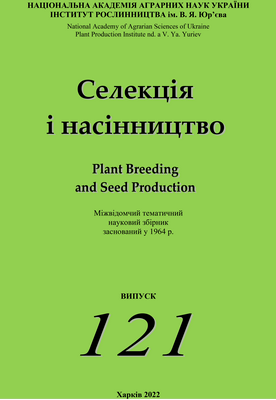Application of bacterial agents on sunflower
DOI:
https://doi.org/10.30835/2413-7510.2022.261002Keywords:
sunflower, yield, bioagents, correlation coefficients, yield incrementsAbstract
The study was aimed to examine the effects of bacterial agents combined with two variants of mineral fertilization on the sunflower yield.
Materials and methods. The main field experiments were carried out in Department of Plant Production and Variety Investigations of the Plant Production Institute named after V.Ya. Yuriev of NAAS of Ukraine in 2016−2018.
The soil was deep granular slightly leached chernozem. It had the following agrochemical parameters: humus content (Tyurin’s method) 5.8%; pH 5.8; hydrolytic acidity 3.29 mg/eq per 100 g of soil. The nutrient reserves in the control (no fertilizer): nitrogen – 132 mg/kg; phosphorus – 104 mg/kg; potassium – 128 mg/kg. The nutrient amounts with mineral fertilizer (N30P30K30): nitrogen – 130-140 mg/kg; phosphorus – 180−200 mg/kg; potassium – 170−190 mg/kg of soil.
Data were statistically processed by variance and correlation analyses.
Results and discussion. In2016-2018, sunflower plants grew and developed under very contrasting weather conditions compared to the multi-year averages. There was a water deficit during the critical periods (anthesis, seed setting and filling), especially at elevated air temperatures.
In the study, biofertilizer GroundFix + bacterial agent HelpRost turned out to be the most effective combination. When GroundFix was used at a dose of 5 L/ha without fertilizer, the yield increased by 0.33 t/ha compared to the control; when it was used with N30P30K30 as basic fertilizer, the gain in the yield amounted to 0.36 t/ha. When the ‘GroundFix 5 L/ha + HelpRost’ combination was applied, the gain was 0.30 and 0.32 t/ha, respectively. The efficiency of HelpRost 3 L/ha in the “5−6 leaf pair” phase of the crop was -0.03 and -0.04 t/ha on the respective mineral fertilization. When the biofertilizer dose was increased to 8 L/ha, the yield was raised by 0.32 and 0.30 t/ha, respectively; when the increased dose was co-applied with HelpRost, the increment was 0.42 and 0.58 t/ha, respectively.
There was a strong positive effect of April temperatures on the yield, with correlation coefficient of 0.36− 0.72, and of June temperatures (r = 0.33−0.59), except for the ‘GroundFix 5 L/ha + HelpRost 3 L/ha’ combination on basic fertilization with N30P30K30 (r = - 0.25 and r = - 0.07, respectively).
Conclusions. When GroundFix was used at a dose of 5 L/ha without fertilizer, the yield increment was 0.33 t/ha compared to the control; when GroundFix was used at the same dose with N30P30K30, the increment amounted to 0.36 t/ha. By combining GroundFix 5 L/ha with HelpRost, we obtained the yield increments of 0.30 and 0.32 t/ha, respectively. Increasing the biofertilizer dose to 8 L/ha gave the yield gain of 0.32 and 0.30 t/ha, respectively. When the increased dose was co-applied with HelpRost, the gain was 0.42 and 0.58 t/ha, respectively.
There was a positive correlation (r = 0.37−1.00) between the yield and precipitation amount during the growing period. We noted a strong positive effect of April temperatures, with correlation coefficient of 0.36−0.72, and of June temperatures (r = 0.33−0.59).
References
Hrigoryeva O, Almaieva T, Haydenko Oleg. Consumption of biopreparations on soybeans: why is it worth it?URL: https://www.growhow.in.ua/zastosuvannia-biopreparativ-na-soi-chomu-tse-vyhidno/.
Sabov S. Energy-saving components of soil-centric technology based on the drug Filazonit.URL: https://agrarnik.com/index.php?option=com_k2&view=item&id=3499:energozberigayuchi-skladovi-gruntotsentrichnoji-tekhnologiji-na-osnovi-preparatu-filazonit&Itemid=434.
Bio questionable. Farmers are in no hurry to switch to biologization.URL: https://www.agroinvestor.ru/analytics/article/32762-bio-pod-voprosom/.
Agroecological bases of highly efficient cultivation of field crops in crop rotations of organic farming. In: ІA Shuvar, red. Lvіv: Ukrayinskі tekhnologіi, 2003. 36 p.
Plant growth stimulants are indispensable assistants for farmers: how to choose and apply them.URL:https://www.5.ua/novyny-kompaniy/stymuliatory-rostu-roslyn-nezaminni-pomichnyky-ahrariiv-iak-ikh-obyraty-ta-zastosovuvaty-171145.html.
Olepіr RV, Slobodianiuk OM. The effect of microbiological preparations on soybean productivity. Proc. of Internat. scien. Internet-conf. «Modern directions of selection, technologies of cultivation and processing of oilseeds», 2017 Nov 16, Zaporіzhzhia. 2017. P. 128−130.
Tkalіch YuІ, Nіtsenko MP. Drought resistance and water consumption of different precocious sunflower hybrids depending on biological products. URL: http://visnyk-cnz-apv.com.ua/assets/files/16/32.pdf.
Klymenko ІІ. Influence of plant growth regulators and microfertilizers on yieldsunflower seed lines and hybrids. Sel. nasіnn. 2015; 107: 183−188. https://doi.org/10.30835/2413-7510.2015.54055.
Increasing the yield of sunflower with the use of biotechnology.URL: https://organik-line.ru/publication/stati/promyshlennyj_sektor/povyshenie-urozhajnosti-podsolnechnika-s-primeneniem-biotexnologij.
Mashchenko Yu, Gajdenko O, Mudrіchenko M. How does fertilizer affect sunflower yield?URL: http://agro-business.com.ua/agro/ahronomiia-sohodni/item/808-iak-vplyvaie-udobrennia-na-urozhainist-soniashnyku.html.
Correlation analysis of the relationship of quantitative characteristics. URL:https://stud.com.ua/93330/statistika/korelyatsiyniy_analiz_vzayemozvyazku_kilkisnih_oznak
Pearson's correlation coefficient. URL: https://uk.wikipedia.org/wiki/Коефіцієнт_кореляції_Пірсона.
Downloads
Published
Issue
Section
License
Copyright (c) 2022 M. H. Tsekhmeistruk

This work is licensed under a Creative Commons Attribution 4.0 International License.
When placing the text in electronic resources, the copyright is reserved by the author of a publication.
Authors may not agree with referee’s(s’) comments and remarks of the Editorial Board, rationalizing their point of view.
Authors may require clarification from or the Editorial Board or changes in the event of significant errors in their article.
Authors can use materials published in the journal Selection and Seed Industry in their work, mandatorily referring to our journal.

